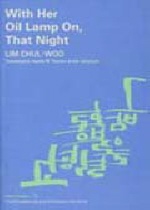
The Book
As is typical in the Portable Library of Korean Literature, Lim Chul-Woo’s “With Her Oil Lamp on, That Night,” contains two shorter works, the title story and “Sapyong Station.” Each is a story of protest, one in protest of the civil war and the other in protest of modernization and militarization.
“With Her Oil Lamp on, That Night” by is a classic mid-century Korean weeper (Wow, I’ve just created a new genre!). It features a combination of hopeless images of separation with a semi-cliched, though also slightly ambiguous, final image of the circle of life.
The story opens with a soldier, in a dwindling company of rebels, in the hills outside the town he grew up in. The town has been emptied by government decree, but he suddenly sees a light there. As his internal dialogue suggests, that light is lit by his mother, come back to town on the anniversary of her husband’s death, and secretly hoping to see her son. While in her home, she prepares an offering for her dead husband. While she is distracted a crazy pregnant woman breaks in and begins eating the offering.
In the meantime, the government has become aware the mother/widow is in town, and has set up an ambush in case any rebels should try to enter the town. The ending is predictably tragic.
Every character has a backstory of death and loss, and the final image (which I will leave unrevealed) is optimistic if a bit hackneyed.
Much of the writing is beautiful, in that Korean bucolic way that so many of these stories feature. There is also some very nice imagery, as of the moon breaking into small pieces in the well when the mother/widow dips her gourd in it.
This is a small piece, but one that would naturally recommend itself to Korean readers of a certain age. Because it relies so heavily on a kind of bitter and heavy-handed romanticization of the Korean division, it might be slightly heavier sledding for foreign readers.
Apparently inspired by the poem “At Sapyong Station” by Gwak Jae-gu, Sapyong Station it is a strangers-thrown-together story, but also a kind of a meditation on the growing schism between Seoul and the countryside.
Unlike “With Her Oil Lamp on, That Night, “ “Sampyong Station” is a bit more transparent for an English reader.
The plot is simple. Observed by the stationmaster, a group of travelers are waiting for a train on a snowy night in Sapyong. Five people are huddled around a sawdust stove. Two are a man with tuberculosis and his brawny son who fight over trifles. A middle-aged man with a beard has just been released from prison. There is also a young man, the hope of his entire village, who has been expelled from college, and finally there is a crazy woman. Later, rour women trundle in. One is a rich fat older woman who is visibly happy the train is late, so she can still catch it. A younger woman, a dancer/hooker in Seoul and two peddlers round out the cast.
Resolutely depressing, “Sapyong Station” explores, with commendable pith, the circumstances and inner lives of its 10 characters. This examination morphs into the question, “what is the meaning of life,” and it becomes clear that none of the potential passengers (8 of the 10 characters) has a meaning for life any larger than a metaphor for their own struggles.
Written in the early 80s, this work is intended to show the corrosive social and ideological effects of modernization and military rule. There is some nice imagistic writing, often focusing on things suspended in air, or pushed by the wind. This, obviously, is symbolic of the passengers, none of whom has the luxury of controlling themselves (even the fat and rich matron from Seoul). In addition, the Express Trains, which rush by the station in a snowy blur are clearly symbolic of Korea’s national destination, one which has no time to truck with any vestiges of the past, or impediments to the national future.
The good news is that none of this historical/social background is needed to understand the story, as Lim writes with an admirable precision and brevity that outlines each character in a few deft strokes and then sets them against each other.
“Sapyong Station” ends with a sentimental gesture, perhaps an indication of a kind of social support left in scattered rural outposts, perhaps a suggestion of what needs to NOT be left behind.
UPDATE: I should add, as per the comment below by Tuttle from the Seoul Patch, that the translation here is awfully rocky, with the kind of simple errors (and some larger ones) that cursory editing should have ironed out.





